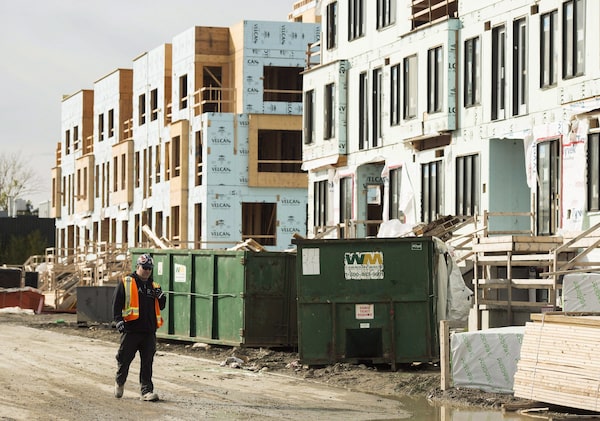
A new townhouse complex is under construction in Toronto on Nov. 3, 2016.Nathan Denette/The Canadian Press
The Ontario of 30 years from now could be full of new places to live. Apartments and rooming houses on every block. Wood-framed buildings 12 storeys tall. Towers around mass transit, including bus stops, even in the most exclusive neighbourhoods.
This is the vision put forward in a report by the Ontario government’s housing affordability task force, chaired by Scotiabank executive Jake Lawrence and released Tuesday. The document is nuanced, bold, clear and radical. It is a map toward a more equitable, more prosperous and more climate-positive society. The key idea: more housing within cities, as quickly as possible.
If the Ford government follows even half the suggestions, the results will fundamentally reshape land-use planning in Ontario and dramatically alter the housing market for the better.
How so? The report recommends doubling the number of homes Ontario builds, starting immediately. The main thrust of the recommendations is to make it easier to build housing in more places.
The task force argues that planning has “become politicized.” While more density really ought to go in urban places, they argue, local politicians have too much power to stop this. Their report is packed with specific recommendations to simplify the building code, urban design rules and heritage regulations, all with the aim of getting things built.
And on the whole, they are right. In Ontario (as in British Columbia, California and New York), prosperous city regions have locked down too much of their land for houses. An excess of consultation and study makes it hard to build housing that people need. Angry neighbours shouting about “character” hold the reins.
This has led to a shortage of housing. “For many years, the province has not built enough housing to meet the needs of our growing population,” the report reads. “While the affordability crisis began in our large cities, it has now spread to smaller towns and rural communities.”
This is exactly correct. Scotiabank research suggests the province is now 1.2 million homes short of the G7 average, relative to its population.
Many observers will find this hard to believe – what about all those new condos? – but it is true. Ontario was building more homes in the 1970s, in absolute numbers, than it has at any point in the past decade.
Does that mean that allowing more construction will make housing as cheap as it was a generation ago? No. But the task force understands the consensus among economists: If you have a shortage of housing, wealthier people will buy and rent it; those with less will be priced out. The message is clear: “We need to build more housing in Ontario.”
That alone is not sufficient, however. Stronger protections for existing tenants are required. Then there is the obvious need for below-market housing, subsidized by government. Such housing makes up a very small fraction of homes in Ontario, and that number needs to grow – by a lot. It’s clear that the Ford government has no interest in this question. The task force pushes back on this point, noting that Ontario is not doing enough.
Lawrence’s group – which also includes Ene Underwood, chief executive officer of Habitat for Humanity Greater Toronto Area – also argues against sprawl. “A shortage of land isn’t the cause of the problem. Land is available,” the report says, “both inside the existing built-up areas and on undeveloped land outside greenbelts.”
All this provides room to change the narrative about housing.
For too long, housing politics have been binary: Either you are for developers, who are generally evil, or you are against them. But the task force’s story is different. Ontario needs to build a lot more housing, right now. Some developers are going to be happy about this. So will people who are looking for a place to live.
With an Ontario election looming in just a few months, there’s space for progressive politicians to embrace this report – to push back on the Ford government’s allegiance to sprawl, end highway projects, and focus relentlessly on making cities denser and better, fast. It’s not clear whether anyone will take this route, but now they have a map.
Our Morning Update and Evening Update newsletters are written by Globe editors, giving you a concise summary of the day’s most important headlines. Sign up today